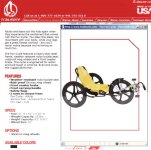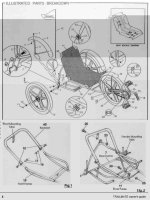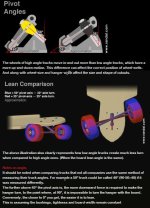overview
Vehicles that lean into turns are inherently more stable and quite a bit more fun than those that do not. By tilting into turns, bicycles and motorcycles have a cornering advantage over automobiles that is physically harmonious and produces a thrilling ride.
But having to balance on two wheels limits the application of these vehicles: Two wheeled vehicles always carry the risk of falling over if they loose traction or the rider otherwise loses control. In light of this, many people are working on multi-wheeled tilting vehicles which would merge the feel and handling capacity of a motorcycle with the security and stability of at least three wheels.
The complexity of engineering tilters has proven to be a significant barrier to mainstreaming them. When was the last time you saw one? Most tilting vehicles in development and production have some sort of mechanism or two stage gizmo that is an active part of vehicle control. As a result, the action of leaning into curves is either not optimized for all speeds, not as responsive as operator might like, or it is prohibitively expensive and complex.
I have designed and developed a tilting three-wheeled suspension that allows for complete control of the tilt angle of wheels and chassis, while retaining independent control of the steering angle, through an innovative application of a four-bar linkage.
The effect is unlike anything I have ever ridden, maximizing every good quality of a two-wheeler with all the stability of three to create a driving experience that simply has to be felt to be believed. Somewhere between skiing, skateboarding and motorcycling, my invention allows for the complete, independent control of leaning and steering in an intuitive, safe and easy way.
Complete tilt control means counter-steering associated with turning two-wheelers is eliminated: To execute a turn, you just dive into it, forcing the chassis to tilt at the same time you turn the wheels. Tilt control reduces the yaw time, --the time it takes to settle into a controlled turnâ€â€to essentially nothing. Additionally, if you hold it in a turn that is too tight for your speed, forcing the chassis to tilt, the three-wheeled configuration is optimized for maximum rollover threshold so it will resist flipping and rather begin to carve, ultimately beginning to drift as the rear wheel loses traction – an incredible sensation once available only to stuntmen and professional riders.
The best part of all of this is that the vehicle still feels exactly like a motorcycle.The tilt control on this prototype in no way detracts from the essential feeling of flight which makes motorcycling so physically exhilarating. Instead it adds depth and dimension and best of all control to this feeling, increasing its parameters and lowering its risk, all without a computer Plus, you don't have to put your feet down when you stop. If all this sounds too good to be true, just wait till you ride it. In the meantime, check out the video.
I have the complete, ready-to-ride prototype and am about to embark on a nationwide tour to promote this design though the appropriate channels. If you would like to schedule an appearance, email wilcoxjoe@gmail.com or call 336-210-6924















